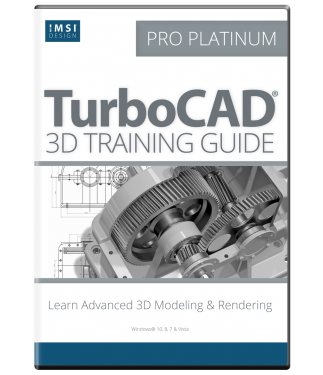3D Training Guide for TurboCAD Pro
Develop 3D Design Skills in TurboCAD Pro
3D Training Guide for TurboCAD Pro is a browser based (HTML) program that teach common 3D CAD skills necessary to efficiently operate TurboCAD Pro for Windows OS. Newly updated for TurboCAD 2016, users learn through easy, step-by-step training sessions. Perfect for a classroom or self-study.
Data Sheet
More Info
Overview
3D Training Guide for TurboCAD
This browser based (HTML) and video training guide teaches common 3D CAD skills through easy to use, step-by-step sessions. It’s designed for anyone wishing to learn TurboCAD in a self-paced, structured session format, but is also appropriate for students learning CAD for the first time in a classroom setting, whether at school, college, university or any educational institution.
The Easiest Way to Learn 3D Computer-Aided Design with TurboCAD
All key 3D features in TurboCAD are presented in this learning system. Following basic introductory sessions are 15 learning sessions that introduce the following activities:
- Session 1 – program and drawing settings for 3D design, the 3D menu panels, selector 2D/3D properties, standard / isometric views, the world and user-coordinate system, workplanes, and 3D thickness
- Session 2 – mirror (3D objects), generic transform, multiple layout templates, fillet edges, and material properties
- Session 3 – 3D box, rotated box, sphere, hemisphere, cylinder, polygonal prism, fillet edges, parametric updates, workplane by facet, using the mirror tool in a 3D application, basic material properties, and paper space layout
- Session 4 – profile node edit, workplane by 3 points, simple extrude and quick pull, dimensioning on the workplane, and viewport layer control
- Session 5 – 2D add, 2D subtract, generic transform, 3D add, 3D subtract, generic transform, 3D selection properties, and toggle 2D/3D
- Session 6 – assembly by 3 points, assembly by edge & point, assembly by facets and tangents, assemble by axis, and shell solid
- Session 7 – solid objects : torus, sphere, revolve, assemble by 3 points, and slice by workplane
- Session 8 – imprint add and subtract, pressure load, extrusion draft angle, compound profile extrusion, extruding to a face, and flexible text
- Session 9 – revolve, workplane intersection, 3D array, the thread tool, and adjusting the faceter mode
- Session 10 – join polyline, assemble by 3 points, using the same profile to extrude bi-directionally, and updating object information using the selection info palette
- Session 11 – loft, branched and face2face lofting, edit current workplane, show/hide workplane intersections, and pressure load.
- Session 12 – section by closed polyline, facet editor, radial copy - 3D, place on workplane, offset, and create holes
- Session 13 – extrusion draft angle, compound profile sweep, twisted extrude, surface from solid, and assemble by edge and facet.
- Session 14 – using the Drafting Palette to do the following: selection by component / assembly, inserting views into the drawing, the view scale and hidden line view, projection views; sectional views, inserting sectional views, aligning sectional views, and multiple paper space layouts
- Session 15 – render modes, display hidden lines as dashed, displaying non-renderable objects, lights, camera properties, camera objects, camera movement, walk through, and render scene environment
How it’s delivered:
This training guide offers browser based (HTML) electronic training sessions that are easy to navigate, link to relevant videos, and allows you to save pages to ‘favorites’. You can even right click to look up terms in Google Dictionary, or use Google Translate to translate phrases or entire pages into your own language.
What’s Included?
- Introduction and TurboCAD Basics to put you on the fast track for learning TurboCAD
- 15 training sessions and over 250 task-specific videos in the 3D training guide
- Session summaries for a concise review of progress
- Rapid Reference Index for quick location of specific topics
- Google Dictionary & Google Translate support
Each session begins with a task worksheet with specific instructions about the session. All sessions are single session, from start to finish, which means drawings can easily be completed in the recommended timeframe. Projects and practical sessions are also included so you can build your own projects from scratch.
System Requirements
Minimum System Requirements:
- Pentium IV Processor
- Internet Browser Fire Fox or Internet Explorer
- Microsoft® Windows® XP 512 MB RAM, Microsoft Windows Vista®, Windows 7 or Windows 8 1 GB
- 300 MB Free Hard Drive Space, 64 MB of Swap Space
- Super VGA (1024 x 768) display
- High Color (16 bit) graphics card
- DVD drive

